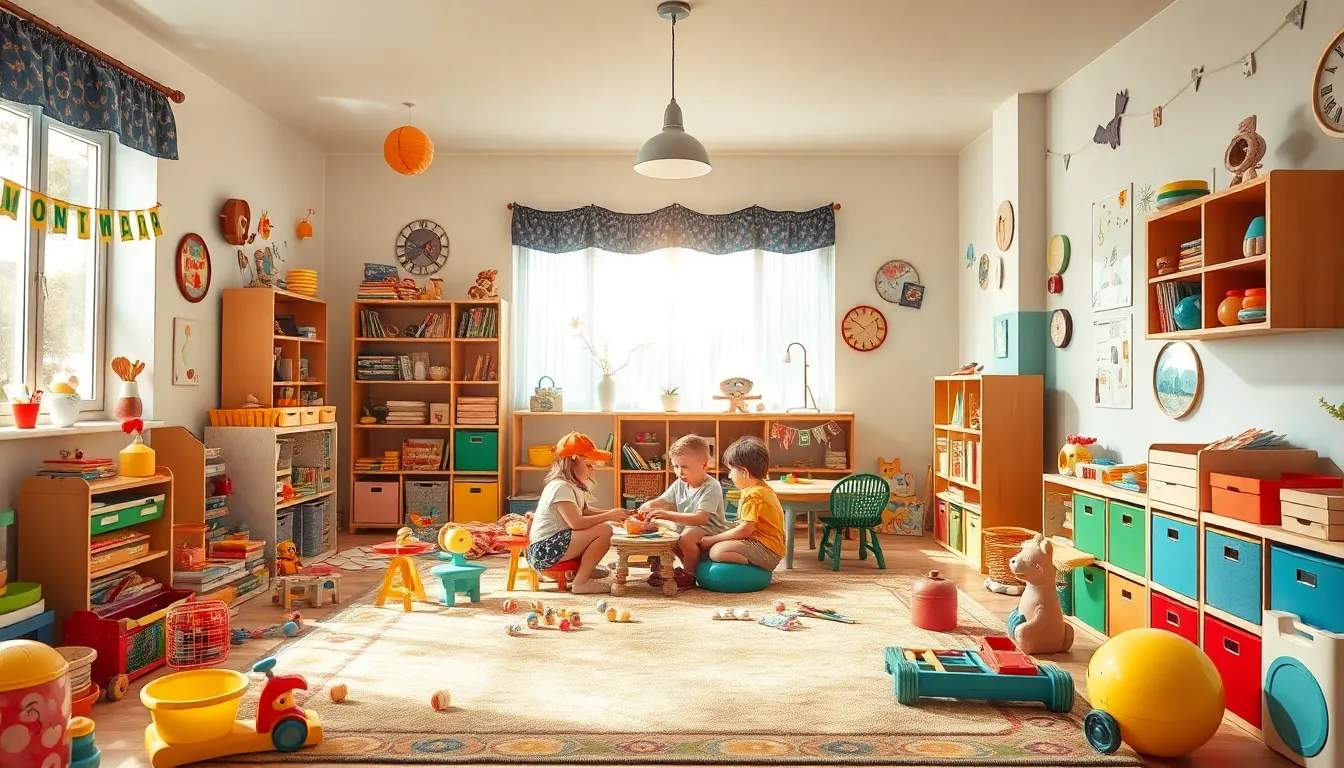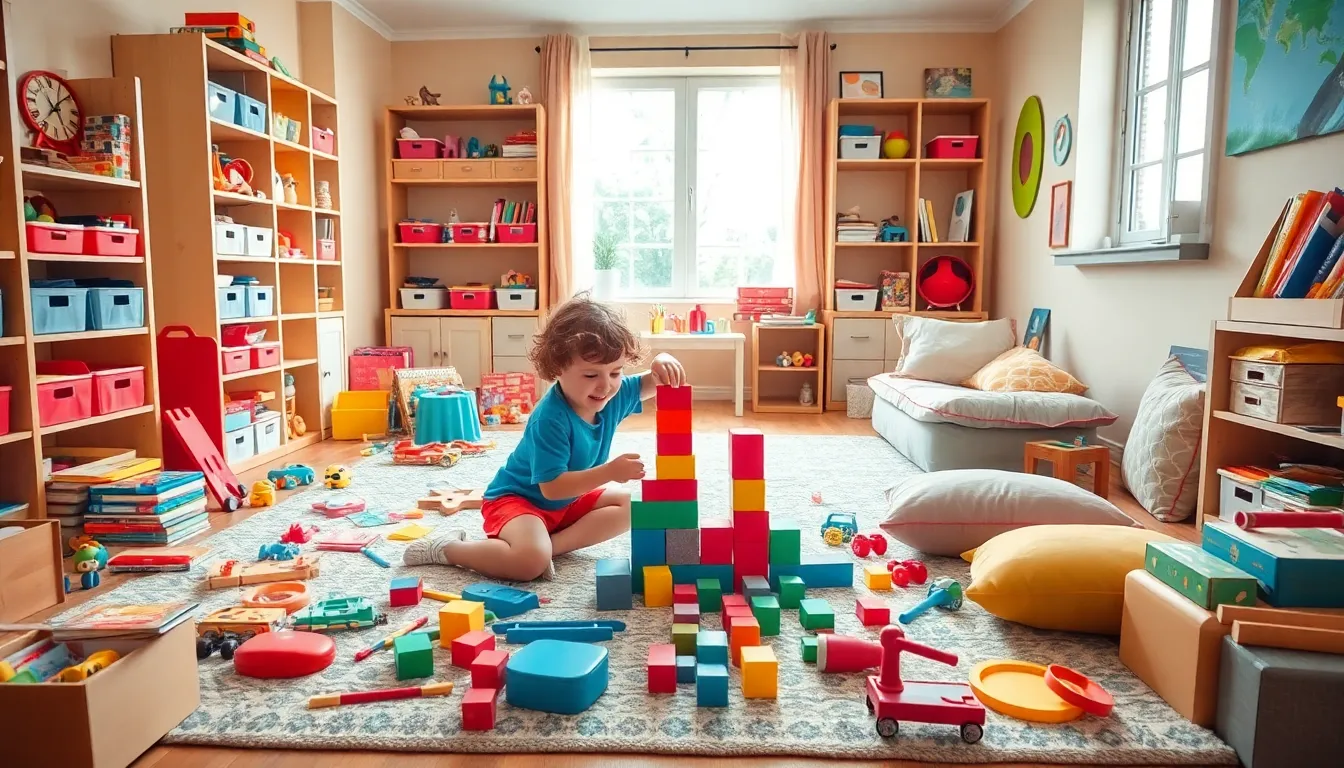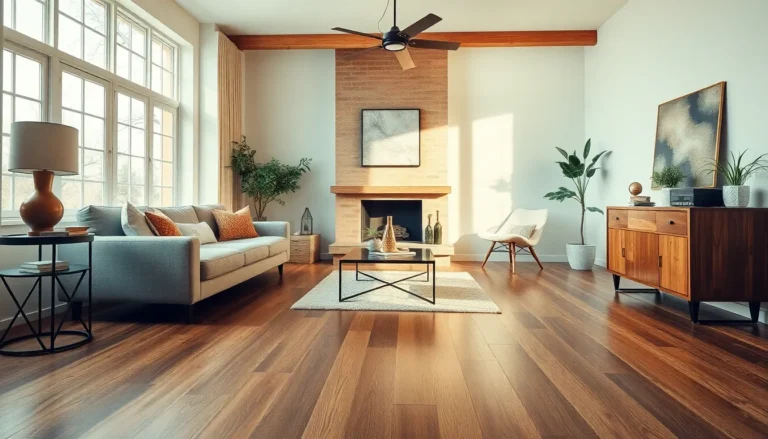Table of Contents
ToggleCreating a kids playroom is like crafting a magical kingdom where imagination reigns supreme. Picture vibrant colors, cozy corners, and endless possibilities for adventure. It’s not just a room; it’s a haven where creativity flourishes and laughter echoes.
Every parent knows that a well-designed playroom can save sanity. Instead of stepping on Lego landmines in the living room, they can watch their little ones explore, learn, and grow in a space tailored just for them. From art stations to reading nooks, a playroom can transform chaos into joy, making it the ultimate parenting win.
What Is a Kids Playroom?
A kids playroom serves as a dedicated space where children can engage in play and explore their creativity. This area might include various toys, books, and crafts, enabling young ones to immerse themselves in imaginative activities. In essence, a playroom offers children the freedom to play without the constraints of more formal settings.
Safety holds paramount importance in a kids playroom, as it ensures a secure environment where children can play without risks. Soft furnishings and age-appropriate toys contribute significantly to this safe space. Parents can design playrooms using bright colors and fun themes, which stimulate children’s senses and encourage exploration.
Organization plays a crucial role in the functionality of a playroom. Storage solutions like bins, shelves, and cubbies help parents maintain order while allowing children to find and access their toys easily. A well-organized playroom reduces clutter, fostering a serene environment conducive to play.
Engagement in a kids playroom can also promote social skills. When children play together, they learn to share, collaborate, and resolve conflicts, all essential life skills. Group activities, from arts and crafts to games, encourage teamwork and enhance communication.
Ultimately, a kids playroom acts as a central hub of fun and learning, promoting both creativity and development. Families can transform a simple room into a vibrant play space, enriching children’s play experiences while offering parents peace of mind.
Benefits of a Kids Playroom

A kids playroom provides many advantages for both children and parents. It creates an environment where little ones can thrive and explore freely.
Encourages Creativity
Creativity flourishes in a well-designed playroom. Children encounter various toys, art supplies, and books that inspire imaginative play. Bright colors and engaging themes stimulate their senses, making exploration exciting. Each play session allows kids to experiment and invent stories, enhancing their cognitive development. Additionally, open spaces enable movement and flexibility, encouraging spontaneous play. Environments filled with resources enable kids to express themselves freely, fostering confidence in their abilities.
Promotes Social Skills
Social skills develop naturally in a dedicated play space. Kids interact with peers, sharing toys and collaborating on projects. Through these interactions, they learn vital conflict resolution strategies and communication techniques. Group activities encourage teamwork, as children must work together to achieve common goals. Meanwhile, parents can facilitate playdates in a contained area, nurturing friendships. Engaging in shared experiences helps kids build empathy and understanding, essential traits for successful relationships. Overall, playrooms serve as valuable settings for social development.
Designing a Perfect Kids Playroom
Creating a well-thought-out playroom involves careful consideration of various elements to meet children’s needs.
Choosing the Right Space
Selecting an appropriate location for the playroom is crucial. Ideally, this area should be spacious enough to accommodate toys and activities. Safety from hazards must be a priority, so choosing a room away from stairs or sharp objects is advisable. Natural light contributes to a positive atmosphere, making rooms with windows or access to outdoor views preferable. Additionally, proximity to common areas allows parents to supervise play actively. Considerations for adjacent rooms aid in sound management, ensuring the playroom can remain vibrant without disrupting the entire home.
Essential Furniture and Accessories
Furniture choices directly impact playroom functionality. Begin with soft seating options, such as bean bags or cushioned chairs, to create a comfortable space. Storage solutions like bins, baskets, and shelves help organize toys, books, and crafts while maintaining a tidy environment. Select a sturdy table for arts and crafts, allowing children ample space to create freely. Colorful rugs add warmth and comfort to the floor, making playtime more inviting. Include sensory activities like a small climbing structure or interactive wall panels, engaging various senses and promoting motor skills. Each item should contribute to a stimulating yet organized play experience.
Safety Considerations
Safety plays a critical role in the design of a kids playroom. Evaluate the space for potential hazards, such as sharp edges on furniture or easily accessible power outlets. Ensuring the environment is free from choking hazards, like small toys or loose parts, is essential for child safety.
Soft furnishings, including padded rugs and cushioned seating, enhance comfort while minimizing injury risks during play. Install safety gates if necessary, particularly in areas adjacent to stairs or other unsafe spaces. Secure heavy furniture to walls to prevent tipping.
Age-appropriate toys contribute significantly to safety. Choose toys that suit the child’s developmental stage, avoiding those with small parts for younger children. Inspect toys regularly for wear and tear, replacing damaged items promptly to prevent accidents.
Non-toxic materials hold importance in the playroom. Look for eco-friendly paints and finishes to maintain air quality and child safety. Use hypoallergenic textiles for furnishings to reduce allergy triggers.
Storage solutions play a pivotal role in maintaining a clutter-free environment. Opt for bins and shelves that are easily accessible for children, promoting independence while preventing tripping hazards. Label storage areas with pictures or words to encourage organization and make clean-up easier.
Ensuring adequate supervision is vital in any playroom setting. Keeping the playroom within sight of common family areas allows for better monitoring without interrupting play. Encourage safety discussions with children, instilling the importance of following rules during playtime to foster a responsible mindset.
By prioritizing these safety considerations, caregivers create a secure, enjoyable environment for children to explore, learn, and play.
Creating a kids playroom is an investment in a child’s development and happiness. This dedicated space not only nurtures creativity and imagination but also fosters social interactions and essential life skills. By prioritizing safety and organization, parents can ensure that playtime remains both enjoyable and productive.
A thoughtfully designed playroom transforms chaos into a harmonious environment where children can thrive. It’s a sanctuary for exploration and learning that benefits both kids and parents alike. With the right elements in place, a kids playroom becomes a cherished part of family life, enriching childhood experiences and creating lasting memories.







